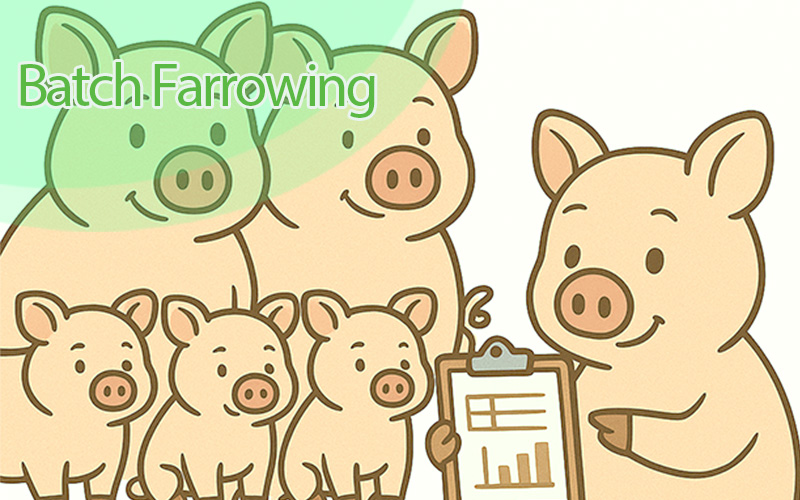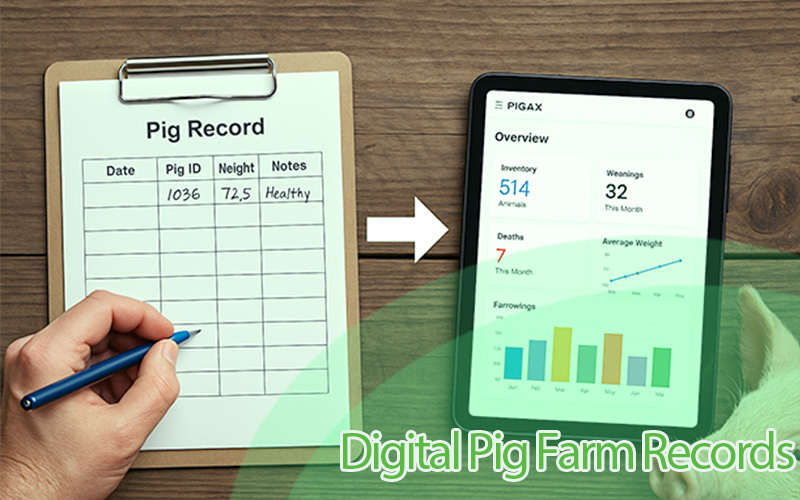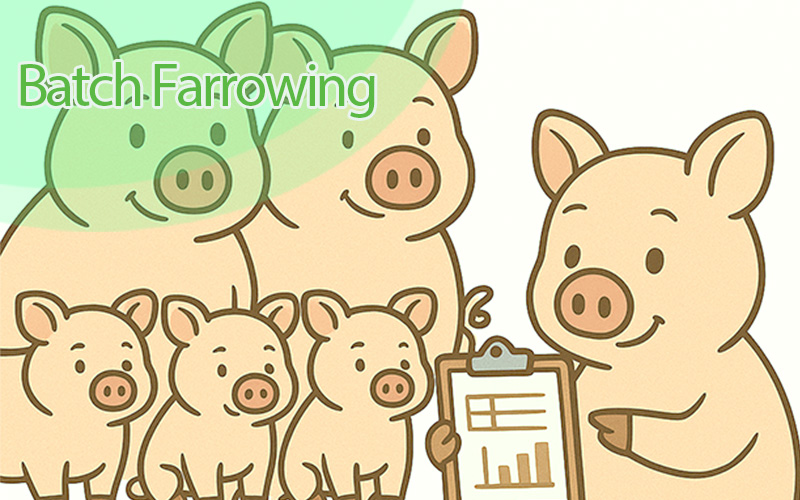Pig Management Glossary
-
All-in-all-out (AIAO): This is a method of managing the pig's population in which all pigs of the same stage of development are brought onto the farm or pen at the same time and moved off at the same time so that there won't be different groups of animals on the same pen.
-
Farm data Analysis: This is a process of interpreting the facts and figures collected on a pig farm in order to make effective decisions on the farm.
-
Average Daily feed intake: The exact amount of feed a pig consumes each day
-
Average Daily Gain: This measures the average amount of weight a pig gains per day
-
Biosecurity measure: A set of protocols and practices that are put in place to prevent the spread of diseases and pathogens on a pig farm. The goal of biosecurity measures is to protect the health and welfare of the animals, as well as the productivity and profitability of the farm.
-
Boar management: The care, feeding, and mating schedule adopted for boars in a pig farm in order to maintain the health, welfare and productivity of the entire pig farming operation.
-
Breeding batch: This refers to a group of sows selected to be bred together at the same time. The sows in a breeding batch are usually managed together throughout their pregnancy and lactation, and their offspring are managed together as well after weaning.
-
Breeding Management: All the practices and techniques used to manage the breeding and reproduction of pigs on a farm.
-
Continuous flow: A pig flow management system, new animals are added to a herd or flock on a regular basis, rather than all at once. This means that there is always a mix of animals at different stages of growth or production on the farm.
-
Cross fostering: Cross fostering is a practice in pig farming where piglets from one litter are moved to another litter at an early age, usually within the first 3-5 days after birth to increase piglets survivability.
-
Culling: This is a common practice in pig farming and involves the process of removing a sow from a herd because it is no longer considered to be productive and profitable
-
Disease control: These measures taken to prevent, diagnose, and treat diseases in animals on a farm in order to maintain the health and welfare of the pigs on the farm
-
Effective piggery management: A term that describes the practices and techniques used to efficiently and effectively raise and care for farm pigs
-
Environmental Management: This refers to the practices and techniques used to manage the environmental conditions on a pig farm such as temperature, sanitation, and biosecurity measures in order to ensure the health, welfare, and productivity of the pigs.
-
Farm Budget: A spending plan based on the income and expenses of a Pig farm over a given period of time
-
Farm Expenses: The business costs incurred by farm operators when running farm operations
-
Farm Inventory: This refers to the process of keeping track of the number of various items and resources that are used on a pig farm, including raw materials and finished products
-
Farm Maintenance cost: This is the cost pig farm managers incur in order to keep building, farm tools, and equipment in good working condition
-
Farm production plan: A pig farm production plan is a comprehensive document that outlines the targets and goals that a pig farming operation is aiming to achieve and the strategies, actions, and resources needed to achieve these goals over a set period of time.
-
Farrow to finish: A type of pig farming where the entire process of breeding, gestation, farrowing, and raising piglets to market weight is done on the same farm. This means that the farm breeds its own sows, raises the piglets from birth, and then sells them for meat.
-
Farrowing operation: This is a pig farm operation that focuses on breeding sows and management of the piglets until they are weaned from the sow and sold to other farmers running the wean-to-finish operation
-
Feed Budget: A planned estimate for feed and nutrition on the farm
-
Feed conversion rate: This is the rate at which a pig converts the feed it consumes into weight gain
-
Feed efficiency: This refers to the relationship between the amount of feed consumed by a pig and the amount of weight gained as a result. It is typically expressed as a ratio or percentage and is used as a measure of the pig's ability to convert feed into growth. It is sometimes referred to as the feed conversion Rate.
-
Feed Inventory: This is a document that shows the amount of feed, in their varieties that is stored or on hand for use in the pig farm
-
Feed Management: This is the process of monitoring the quantity, quality, and cost of feeds fed to farm pigs to ensure their growth and development
-
Feed Mix: A combination of different types of feed ingredients that are mixed together to provide the necessary nutrients for the pigs to perform at their best.
-
Feed Plan: This describes the document that outlines the specific types and amounts of feed that will be provided to a specific group of pigs and states the goal the feed is intended to achieve such as maintaining health, promoting growth, or increasing milk production.
-
Feeding cost: This is the total cost of feeding farm pigs over a given period of time
-
Feeding schedule: A plan that outlines when and how often a pig or group of pigs should be fed. This can include the type and amount of food to be provided, as well as the specific times of day that the animal should be fed
-
Free range: This is a system of pig farming where pigs have access to outdoors and are allowed to move freely in open fields. This system allows pigs to express their natural behaviors such as foraging, rooting, and exploring, and to have exposure to sunlight and fresh air.
-
Health Management: This is a process of monitoring and improving the health status of farm pigs at every stage of their development and growth.
-
Health Records: The registers in which the health status of farm pigs is systematically recorded
-
Intensive Pig farming: a method of raising pigs in which large numbers of animals are kept in confined spaces, characterized by high stocking densities, controlled temperature, and a high level of automation.
-
Key Performance Indicators (KPI’s): (KPIs) help farmers to monitor and track the progress of their operation and identify areas that need improvement. Some major Key indicators may include FCR, ADG, pregnancy rate, disease control e.t.c.
-
Labor management: This refers to organising and supervising the human resources involved in the operational activities of a pig farm such as feeding, biosecurity, and sanitation in order the achieve the overall goal of the pig farm
- Dung Management: This refers to the process of handling, collecting, and storing dung on the pig farm in order to protect the health of the pigs and the immediate environment
-
Mating schedule: This is also known as the breeding schedule and is developed by the farm manager outlining when and how pigs should be bred on the farm. This usually includes intervals between breeding based on the overall production plan of the farm.
-
Mortality management: This refers to the process of disposing of deceased pigs on the farm in a way to maintain the health of the remaining pigs on the farm
-
Mortality rate: This is a measure of the frequency of occurrence of death in a Pig farm during a specified interval.
-
Organic pig management: This is a popular management method that refers to the method of raising pigs using organic farming practices which involves using feed that is free from genetically modified organisms (GMOs) and synthetic chemicals.
-
Pen numbering: A system used to identify and organize individual pens or enclosures within a pig farm using unique numbers in order to track the animals within the pen
-
Pig Data Collection: This is the process of gathering facts and figures about day-to-day activities on the pig farm
-
Pig Data: These are facts and figures about the day-to-day activities of an individual pig on the farm that can show how well the pig is performing.
-
Pig Farm capacity: This refers to the maximum number of pigs that a farm can hold or raise at one time. It depends on several factors such as the size of the farm, the type of pig farming operation, and the available resources and infrastructure.
-
Pig Farm Data: These are facts and figures about day-to-day activities on the pig farm that can show how well a pig farm is performing.
-
Pig Farm Diary: A record-keeping system used to document vital information about the welfare of farm pigs at different stages of their development
-
Pig Farm Manager: The person with the responsibility of planning and directing all the production phases in a pig farm and is also referred to as the piggery manager
-
Pig Farm Records: The registers in which the day-to-day maintenance of farm production and financial activities of a Pig farm are recorded systematically or chronologically
-
Pig flow: This refers to the movement of pigs through different stages of the production process on a pig farm
-
Pig Management App: A mobile application compatible with smartphones and tablets designed with a variety of features and functionalities to assist pig farmers with tracking, record keeping, and all the day-to-day managerial tasks on the pig farm and can sometimes be referred to as a swine management app or piggery app.
-
Pig Management Software: A computer program designed to assist piggery managers with the farm’s day-to-day operations like tracking pig inventory, managing feeding schedules, monitoring pig growth, and sometimes providing financial management solutions. It is also known as piggery management software or swine management software.
-
Pig Management System: This refers to a set of procedures and techniques involved in effectively managing a pig farming operation and is also known as a piggery management system or swine management system
-
Pig Management: This is the control of a number of factors such as housing, feeding, breeding health, and records, to allow pigs to perform to the maximum of their genetic potential and yield the required profits on a piggery venture. This is also referred to as swine management, piggery management, or pig farm management.
-
Pig movement tracking: This refers to the monitoring and recording of a pig's location as they progress from one pen to another throughout its developmental stages.
-
Pig numbering: Pig numbering is the process of assigning unique identification numbers to individual pigs in a herd for easy identification of individual pigs. This is typically done through the use of ear tags or tattoos, which are attached to the ear or other visible part of the pig's body.
-
Pig Production costs: This is a sum of all costs incurred in raising farm pigs from start to finish until they are ready for sale.
-
Pig Profile: A pig profile is a set of information and data that pertains to an individual pig, usually collected and stored in a pig management software, and it can include details such as the pig's breed, sex, birthdate, parentage, identification number, weight, health status, vaccination history, and performance data.
-
Pig registration: This is the process of adding a new pig to a pig management software, it requires information about the pig such as birth date, breed, gender, and parentage to ensure proper record keeping of individual pigs.
-
Piglet survival rate: Piglet survivability refers to the rate at which piglets survive from birth to weaning. higher survivability rate leads to greater profitability and productivity.
-
Pregnancy monitor: This is a feature on a pig management software that indicates the day a sow will farrow based on the date it was mated.
-
Routine medications: These are prevention medications prescribed by a veterinarian and are administered periodically to pigs in order to maintain their health and prevent illness and diseases.
-
Sales Report: This is a document or presentation that provides information about the performance of a pig farm’s sales operations. It contains data such as revenue, sales volume, number of sales, and customer demographics
-
Sanitation schedule: A farm sanitation schedule is a plan that outlines the steps and frequency for cleaning and disinfecting the facilities, equipment, and surroundings of a pig farm. The goal of a farm sanitation schedule is to maintain a clean and hygienic environment to prevent the spread of disease and promote the health and welfare of the animals.
-
Semi-intensive Pig farming: A method of raising pigs that falls between the extremes of intensive and extensive farming
-
SOP (Standard Operational Procedures): In pig management, SOPs are a set of detailed instructions outlining the procedures that should be followed to ensure consistent and optimal performance in the management of a pig herd. These procedures may cover various topics, including feeding, breeding, housing, health, and biosecurity.
- Sorting: Pig sorting refers to the process of separating pigs into different groups based on certain criteria, such as weight, age, or breeding status, mostly done in commercial pig farming operations.
-
Sow longevity: This refers to the lifespan of a female pig, also known as a sow, from the time it is born until the time it dies
-
Sow Management: A process that ensures that sows are given the best care to ensure they reproduce and perform efficiently throughout their stay on the farm.
-
Temperature management: This typically refers to the process of controlling and maintaining the temperature inside the pig's housing and facilities to ensure the comfort and health of the animals.
-
Traceability report: This is a document that provides information on the movement of pigs through the production process, from the farm of origin to the final destination.
-
Vaccine management: This refers to the process of planning, administering, and monitoring the use of vaccines in a pig farm. it also involves determining the appropriate schedule as well as the proper records to keep.
-
Vaccine Schedule: This refers to a plan developed by a veterinarian that outlines when and how often pigs should be vaccinated on the farm. it also states the type and dosage of the vaccine to be administered.
-
Wean to finish: This is a pig farm operation that does not breed its own sows or handle the farrowing process but rather only raises piglets from weaning, which is the point when piglets are no longer nursing from the sow and start to eat solid feed




